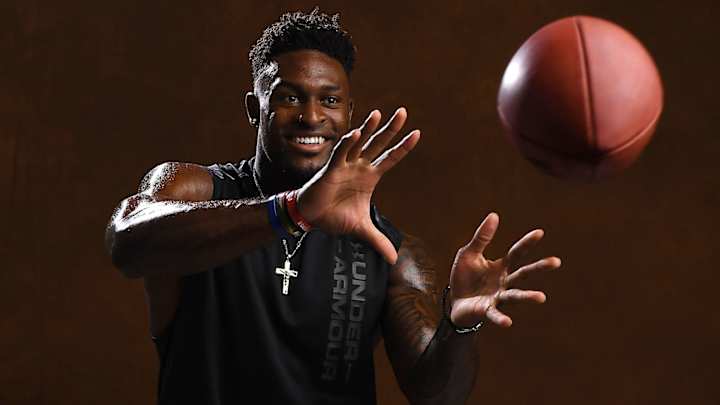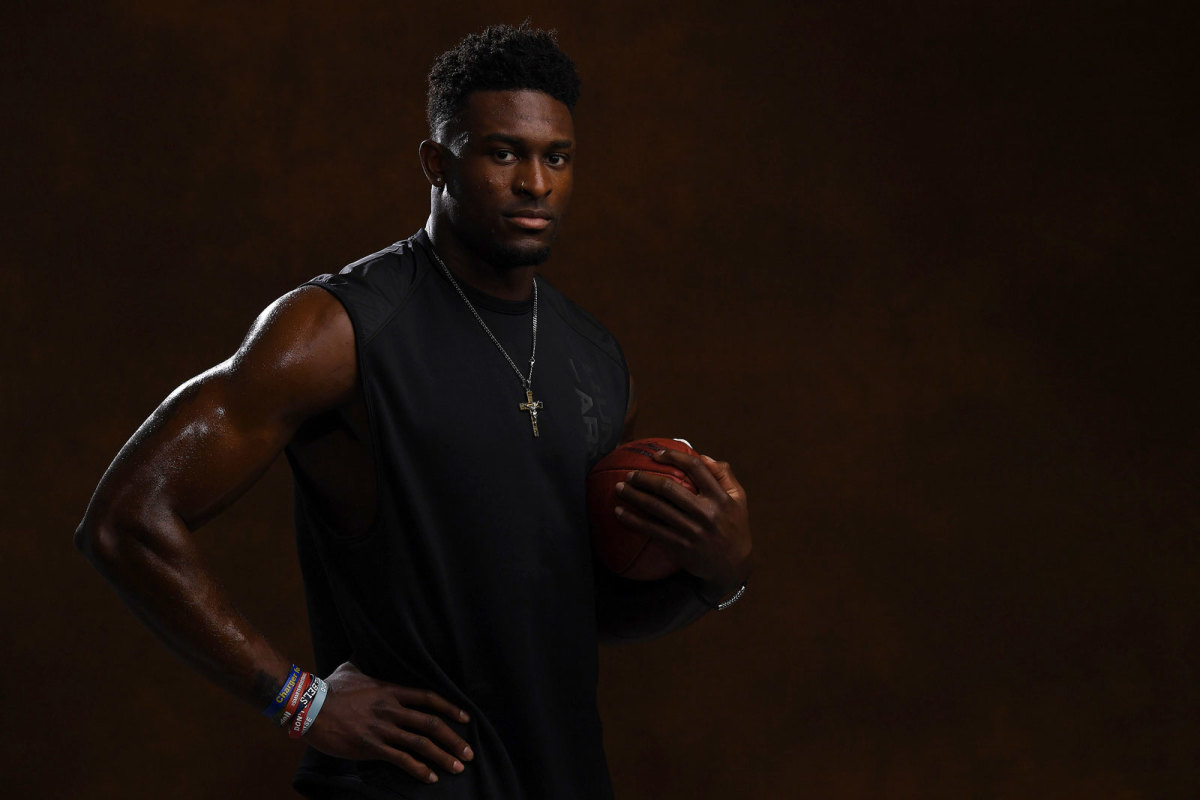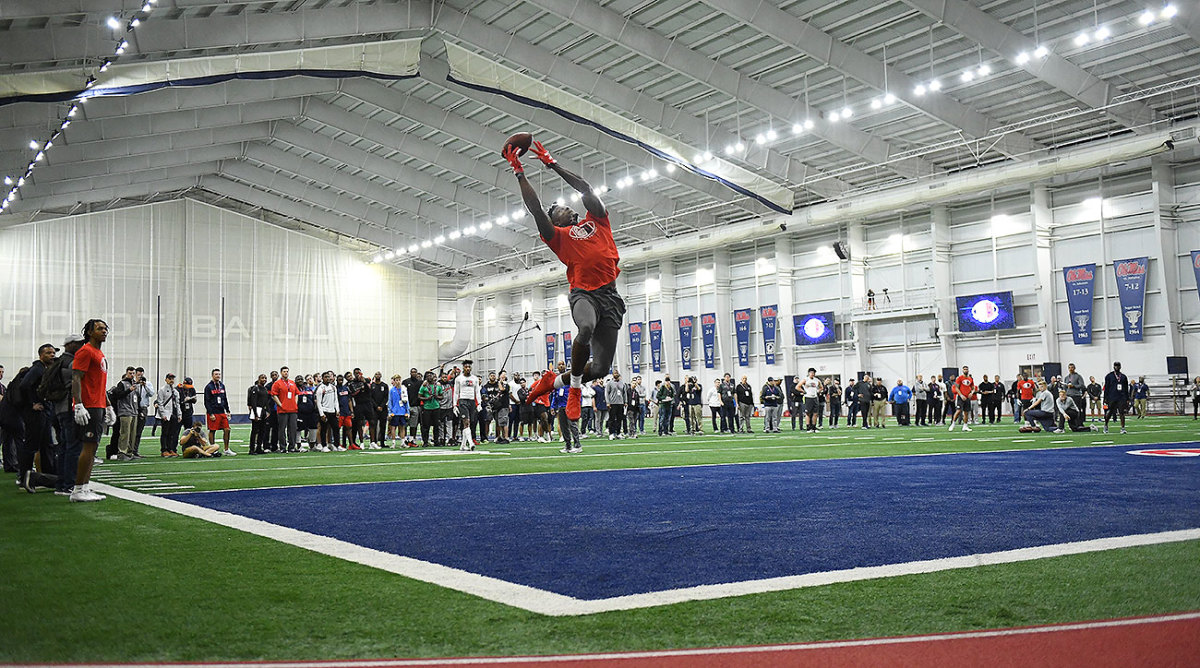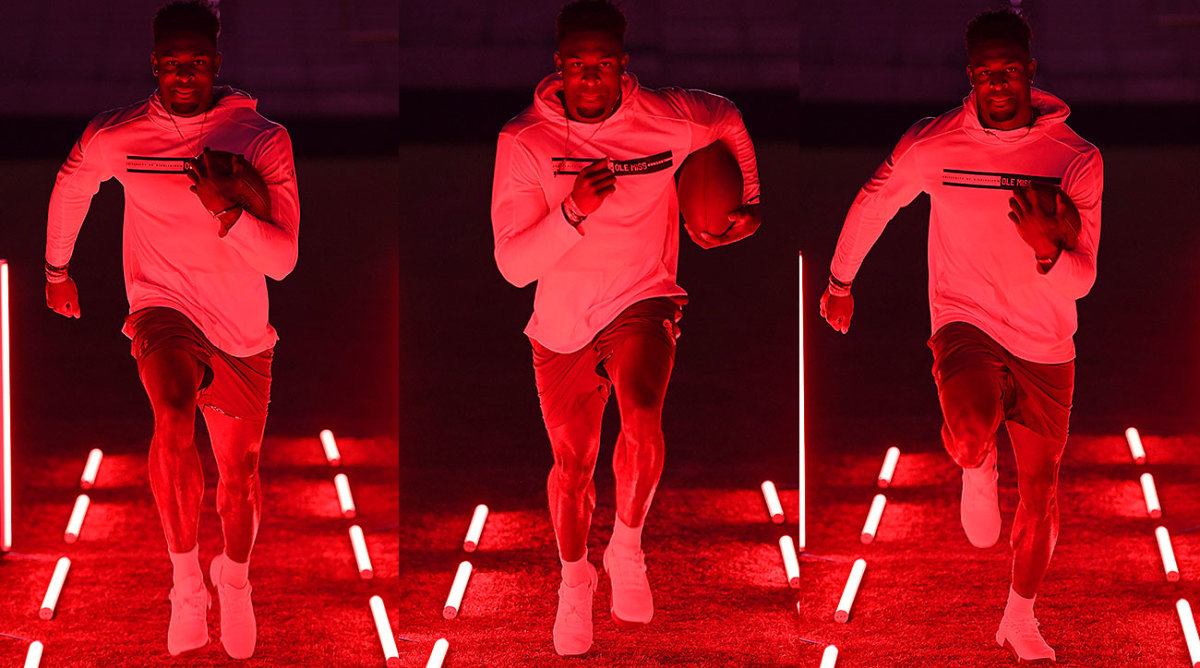D.K. Metcalf Measures Off the Charts, But Will He Fit into the NFL?

This story appears in the April 22-29, 2019, issue of Sports Illustrated. For more great storytelling and in-depth analysis, subscribe to the magazine—and get up to 94% off the cover price. Click here for more.
D.K. Metcalf does not want to take his shirt off for this photo shoot, because he never does. He always declines when asked, he says, and today is no different. That’s surprising, considering the thing Metcalf is most famous for is a picture with his shirt off.
Likely to be the first receiver taken in this month’s NFL draft, Metcalf spent three seasons at Mississippi, but his singular image is not a touchdown catch in a must-win SEC game—or him playing football at all. It's a viral photo from a February gym session that first surfaced on Twitter, the one in which Metcalf looks more like a WWE star than a football player, much less a wide receiver.
DK Metcalf has somehow gotten bigger since last we saw him pic.twitter.com/DdkEZ2my6g
— Bunkie Perkins (@BunkiePerkins) February 11, 2019
People asked him if it was Photoshopped. His parents read accusations of steroid use. A TMZ reporter sent him a direct message on Twitter asking to do a story, which he declined.
Now the photographer tries to persuade him one last time as he changes outfits. Metcalf slips off his black T-shirt depicting the “Bye, Felicia” scene in the 1995 film Friday, but after a nervous, awkward stare and a slight head shake, he has on a black Under Armour tank top.
“I don’t like to show off my body like that,” says the 20-year-old Metcalf. “I’m going to have a wife one day, and she's going to be like, ‘Why are all these pictures of you on the Internet shirtless? What were you trying to do?' I don’t want that question to pop up or anything like that. Or for somebody to think, Oh he’s cocky about his body. None of that.”
Little has been normal for Metcalf since the photo—and then his equally viral NFL combine. In his hometown of Oxford, Miss., he now has his food delivered, and he goes to Walmart only at night.
At 6' 3 3/8" and 228 pounds, Metcalf registered 1.9% body fat at the combine, prompting a flood of stories about his physique—and pointing out that 1.9% is well below the level required for a human to function. Since Metcalf appears to be functioning just fine (he ran faster and bench-pressed more reps than any other receiver in history who's weighed at least 225 pounds), the consensus out of the combine was that he is so lean, he broke the machine that measures body fat.
The NFL had never seen anything close to a player with Metcalf’s measurables at receiver. With the draft approaching, his body has become a topic of fascination, wonder and worry for scouts and executives. (One AFC team asked him if he wants to be a model.) He could go as high as No. 9 to Buffalo, but could also drop. The Ravens, who pick 22nd, have shown strong interest.
That same chiseled body suffered a broken foot and a fractured neck in three years of college. And at his record-setting combine, Metcalf's change-of-direction times were slower than what Tom Brady clocked coming out of Michigan in 2000, leading teams to worry that his frame won't allow him to run more than three or four routes.
Metcalf looks up to and models his game after Julio Jones and Calvin Johnson. But his agility scores are more similar to Jon Baldwin, a big-bodied first-round pick who barely lasted three years in the league.
Metcalf bristles at the notion that he's going to be another big-receiver bust, pointing to his 4.33-second 40-yard dash and 27 reps on the bench at his size.
“They need to stop comparing me to past people,” Metcalf says. “Ain’t nobody ever did what I did, so ... ”

Metcalf entered Oxford High School at 5' 11” and just 130 pounds. You could forgive his classmates if they didn’t immediately realize he was the son of Terrence Metcalf, the former All-American offensive lineman at Mississippi who played seven seasons with the Chicago Bears.
“It was basically between ninth and 10th [grade] where that body—you went, ‘Uh-oh,’” says Michael Abraham, an Oxford dentist who was Metcalf's pee-wee football coach. As a middle-schooler Metcalf had trained with his dad, but he began taking weightlifting more seriously the summer after his freshman year. As he grew, colleges took an interest. Within a three-day span, Metcalf received offers from Charleston Southern, then Duke and finally Mississippi. He committed to his hometown school the next day.
There’s a photo his dad shows of Metcalf, in 10th or 11th grade, broad jumping at a camp, shirtless. His arms are above his head, veins popping, biceps and triceps flexed, a six-pack well-defined.
But in basketball games, Metcalf would usually wear short-sleeved shirts under his jerseys. Even then, he wasn't one to show off. “I know I would have,” his father says.
Metcalf shot up to 6' 4" and weighed 210 by the time he got to Mississippi in 2016. At a summer camp the school hosted, an FBS head coach pointed to Metcalf and remarked to Paul Jackson, the Rebels’ strength coach, that the team had a good-looking defensive end.
Metcalf’s physique was already presenting a challenge. “He’s tall, long, broad, muscled-up. You always worry this kid is going to gain weight,” Jackson says. “Is he going to be a receiver or D end or outside linebacker? Can he maintain his speed and his movement skills as he naturally develops? From 18 to 21 you’re going to gain some weight, you don’t know how big he’s going to get. He could end up 260.
“I said, I don’t know what this is going to morph into, so we need to make sure his movement skills stay like a receiver.”
In the weight room, Metcalf behaved more like a lineman than a pass-catching diva. Jackson would ask receivers to curl the 40-pound dumbbells and Metcalf would get the 45s. He power-cleaned 355 pounds, a record for a Rebels receiver, and benched 365. He would either work out with his dad or the team in the morning, then go to class, then practice and then go home. “If I couldn’t sleep, I’d go work out again,” Metcalf says.
As he got bigger, he added muscle but not much fat. Mississippi’s strength program emphasizes on-field training, away from the weight room, allowing Jackson to monitor players’ speed and agility. He watched closely for any dips in those areas from Metcalf. “But that never occurred,” Jackson says. “As a matter of fact, he kept getting faster.”
In his freshman season, Metcalf suffered a broken foot on his second catch—and second touchdown—and received a medical redshirt. The next year Mississippi was 3–5 heading into a game against Kentucky with an interim coach, Matt Luke, trying to navigate a two-year bowl ban and scholarship reductions. The previous week the Rebels had blown a 31–7 second-quarter lead in a loss to Arkansas, and Mississippi seemed destined for a coaching search that would, at least temporarily, set the program back even further.
In a back-and-forth contest, the Rebels drove down the field and got to the Kentucky seven-yard line with 10 seconds remaining in the game and the Wildcats leading 34–30. Metcalf took an inside release and ran to the back left corner of the end zone, where quarterback Jordan Ta’amu had lofted up a pass. Lonnie Johnson Jr., Kentucky's 6' 3", 206-pound cornerback, desperately held on to Metcalf but was overpowered. With Johnson’s arm and helmet between him and the ball, Metcalf grabbed the pass with two strong hands then clutched it in his right as he hit the ground for the game-winning score.
As refs reviewed the play, Metcalf took a wrestling championship belt the receivers used as a TD trophy, handed it to Luke on the side-line, hugged him and shouted, “I got you.”
“The play he made against Kentucky is probably the reason I’m sitting here right now,” Luke says sitting in his office, attempting to hide his emotions. “Let’s just call it like it is.”
But is he too big to play receiver? “Whoever has that question,” Metcalf says, “COME OUT AND GUARD ME, and you tell me if I'm too big to play receiver.”
Mississippi started the 2018 season—Metcalf’s third year—by winning four of six games. Metcalf was third in the SEC in receiving yards, and according to Pro Football Focus, he ranked first among all receivers over the previous three seasons on go-route catches, averaging 50 yards per reception. The Rebels were entering the meat of their schedule with their best red zone target finally hitting his stride. Then he fractured his neck. A hit under the chin against Arkansas sent his head back and to the right. The medical staff at first thought he had suffered whiplash. But Metcalf learned the next day at the hospital he had chipped his C3 vertebrae. It was unclear if he’d be able to play football again without risking permanent injury.
“I told him, ‘It’s O.K., DeKaylin. People have broken their necks and still played,’” says his mother, Tonya, who admits she had no idea at the time if that was true.
Immediately after, Metcalf heard three stories of people with similar injuries. Two were paralyzed and one had died. But Metcalf had fusion surgery within a week and by January was cleared to play football again. His doctor told him his injury didn't make him any more susceptible to a reoccurrence.
“When I’m around him I get emotional because I just know what could have been,” Terrence says. “We could have had a kid in a wheelchair. Or we could have had a kid who passed away.... You don't take any of this lightly.”
Metcalf promised not to waste his opportunity. With his dad, he started using a motto during training: Set the ceiling.
“He told me one day to be the ceiling, don't reach for it. Be who everybody’s chasing. Be who everybody’s trying to beat,” Metcalf says. “I tried to go into the combine to be the best at every category, and I almost did that.”

Metcalf entered the combine with fanfare topped only by that of Heisman winner Kyler Murray. Metcalf had the viral photo to thank for that. Since December, he had been working out for the combine at EXOS, a training facility in Phoenix, and one Saturday in February he and several other prospects spent the day in the gym working on their arms.
At the end of the pump, fellow Mississippi receiver A.J. Brown was feeling good about how he looked, and it was his idea to line up the guys and take a picture. Metcalf, who had been training with a shirt on, wasn’t going to pop it off. “They’re like, ‘D.K., you gotta take your shirt off.’”
Metcalf stood at the end of the line—his arms, in this moment, bigger than they normally would be and with abs clearly defined and perfectly symmetrical. To his left was Boise State running back Alex Mattison, a 5' 11" 221-pounder who would go on to bench 225 pounds 22 times at the combine. But he was dwarfed beside Metcalf.
“I felt bad for that guy,” says Jackson, the strength coach.
But the photo also showed potential vulnerabilities—a receiver too muscle-bound to go up and extend for a 50/50 ball. A chest so large NFL cornerbacks could easily find a target in press coverage. An upper body so massive it can’t turn fluidly in concert with the lower body. A frame so difficult to take down that defensive backs will aim for his knees, putting him at greater injury risk.
Metcalf says he was 235 pounds—five above his college weight—when the photo was taken and will likely never be that big again. As Mississippi receivers coach Jacob Peeler says, “You’re always going to give up something to get something.”
But is he too big to play receiver?
“Whoever has that question,” Metcalf says, “come out and guard me, and you tell me if I’m too big to play receiver. That’s all I got to say.”
His gifts are so immense that they could trump all the traditional red flags. He completed just 19 college games, with injuries bookending his career. He never had more than 700 yards in a season and never placed in the top two in receiving yards on his team. Though his coaches promise he ran every route in practice, Metcalf essentially ran just three routes in games for the Rebels—the hitch, slant and go.
But Metcalf’s straight-ahead speed is among the best of all receivers, regardless of size. His 4.33-second 40 is tied for 13th best at the combine since 2006, and it’s more than a 0.1 of a second faster than the average first-round wide receiver since ’03. He cried with his mom on FaceTime after the drill, and by that point he says he was ready to fly home. That's how he explains his lack-luster times in the three-cone drill and 20-yard shuttle run, two drills that gauge a player's quickness and ability to change directions.
Metcalf's three-cone time of 7.38 seconds would have just edged 306-pound Garrett Bradbury for the fastest among offensive linemen, and it's almost 0.8 of a second slower than what Julio Jones posted in 2011. Three defensive tackles at this year's combine beat his shuttle time of 4.5 seconds.
He shaved time off both drills at his pro day last month, timed by one AFC scout at 7.23 in the three-cone and 4.39 in the shuttle. “They shouldn't have any more questions about anything,” says Metcalf.
In person, at his pro day, Metcalf appeared much more Bruce Banner than Incredible Hulk—he was clearly ripped, but not comically large. While his body still makes running a good dig route seem impossible, it also lends itself to running a slant or go better than just about anyone. “For some teams that will be O.K.,” one AFC executive says. “Throw it up there and tell him to go get it.”
“I hear the same things,” Peeler says. “Here's a 6' 3", 230-pound kid who runs a 4.3, so we've got to find something to knock him on.
“He is a lot better at the top of the route than he was. He’s far from where he wants to be, and I think that will come with reps and time. Here’s a kid who’s played essentially a year and a half of college football. I think his best ball is ahead of him.”

In the weeks leading up to the combine, Metcalf had a recurring dream. He remembers it happening two or three times, maybe more that he forgot.
He’s at the combine starting line in Indianapolis’s Lucas Oil Stadium. He’s running the 40. Arms pumping. Metcalf likes to think he runs like a gazelle, but in reality, he’s more like a freight train, barreling ahead so violently that you pity any human who steps in the way. But maybe that’s fitting for someone who’s always shied from attention, even though he’s the one player in the draft no one can stop looking at.
He crosses the finish line and, as soon as he looks up for his time, wakes up.
“I was happy,” Metcalf says describing his feelings upon waking. Not nervous or anxious or frustrated. Happy.
“I was ready to go work out.”
Question or comment? Email us at talkback@themmqb.com.
